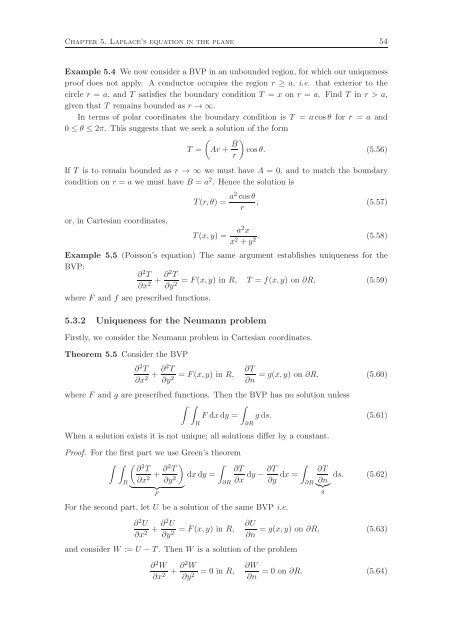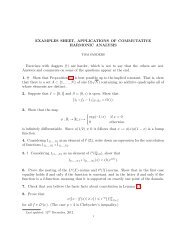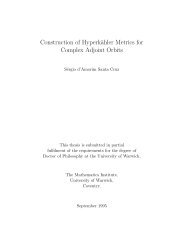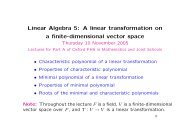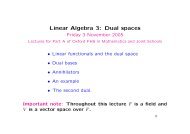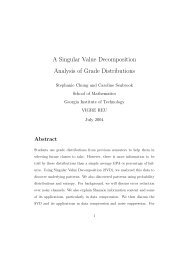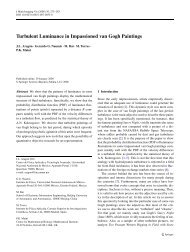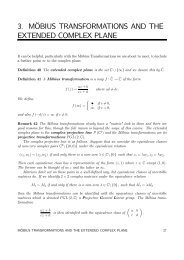Fourier Series and Partial Differential Equations Lecture Notes
Fourier Series and Partial Differential Equations Lecture Notes
Fourier Series and Partial Differential Equations Lecture Notes
Create successful ePaper yourself
Turn your PDF publications into a flip-book with our unique Google optimized e-Paper software.
Chapter 5. Laplace’s equation in the plane 54<br />
Example 5.4 We now consider a BVP in an unbounded region, for which our uniqueness<br />
proof does not apply. A conductor occupies the region r ≥ a, i.e. that exterior to the<br />
circle r = a, <strong>and</strong> T satisfies the boundary condition T = x on r = a. Find T in r > a,<br />
given that T remains bounded as r → ∞.<br />
In terms of polar coordinates the boundary condition is T = acosθ for r = a <strong>and</strong><br />
0 ≤ θ ≤ 2π. This suggests that we seek a solution of the form<br />
<br />
T = Ar + B<br />
<br />
cosθ. (5.56)<br />
r<br />
If T is to remain bounded as r → ∞ we must have A = 0, <strong>and</strong> to match the boundary<br />
condition on r = a we must have B = a 2 . Hence the solution is<br />
or, in Cartesian coordinates,<br />
T(r,θ) = a2cosθ , (5.57)<br />
r<br />
T(x,y) = a2 x<br />
x 2 +y 2.<br />
(5.58)<br />
Example 5.5 (Poisson’s equation) The same argument establishes uniqueness for the<br />
BVP:<br />
∂2T ∂x2 + ∂2T = F(x,y) in R, T = f(x,y) on ∂R,<br />
∂y2 (5.59)<br />
where F <strong>and</strong> f are prescribed functions.<br />
5.3.2 Uniqueness for the Neumann problem<br />
Firstly, we consider the Neumann problem in Cartesian coordinates.<br />
Theorem 5.5 Consider the BVP<br />
∂2T ∂x2 + ∂2T = F(x,y) in R,<br />
∂y2 ∂T<br />
∂n<br />
= g(x,y) on ∂R, (5.60)<br />
where F <strong>and</strong> g are prescribed functions. Then the BVP has no solution unless<br />
<br />
F dxdy = gds. (5.61)<br />
R<br />
When a solution exists it is not unique; all solutions differ by a constant.<br />
Proof. For the first part we use Green’s theorem<br />
<br />
∂2T R ∂x2 + ∂2T ∂y2 <br />
∂T ∂T<br />
dxdy = dy −<br />
∂R ∂x ∂y<br />
<br />
F<br />
For the second part, let U be a solution of the same BVP i.e.<br />
∂2U ∂x2 + ∂2U = F(x,y) in R,<br />
∂y2 ∂R<br />
∂U<br />
∂n<br />
<br />
dx =<br />
<strong>and</strong> consider W := U −T. Then W is a solution of the problem<br />
∂2W ∂x2 + ∂2W = 0 in R,<br />
∂y2 ∂W<br />
∂n<br />
∂R<br />
∂T<br />
∂n<br />
g<br />
ds. (5.62)<br />
= g(x,y) on ∂R, (5.63)<br />
= 0 on ∂R. (5.64)


